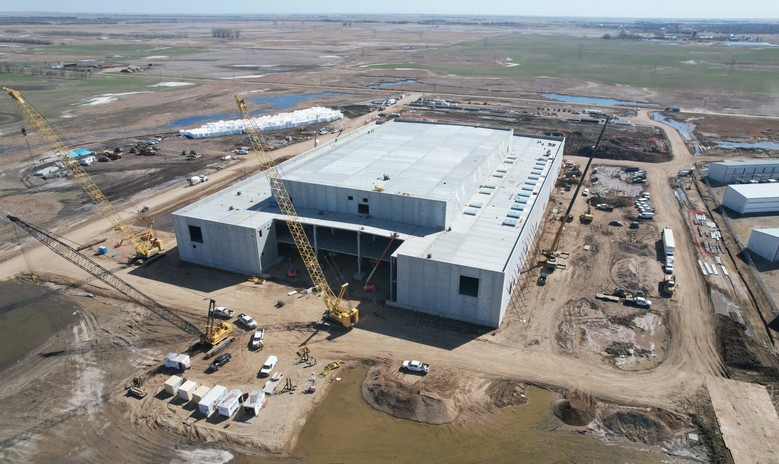Building heavy tech infrastructure on weak ground presents a major challenge. The Applied Digital data center in Ellendale, North Dakota, needed a structurally sound solution that could be installed quickly within its March-to-October 2024 schedule. The project required roughly 25,000 cubic yards of material to create a stable base. The answer was an unexpected one: a material that was both lightweight and strong. The solution came from an unexpected direction. Not from heavier, stronger materials, but from one that is remarkably lightweight yet incredibly strong.
What Exactly Is Geofoam?
Geofoam is a lightweight fill made from expanded polystyrene (EPS) blocks that weighs only 1-2% of soil’s weight. This makes it up to 100 times lighter than traditional fill, yet it maintains similar strength. This balance of being both light and strong makes it ideal for challenging soil conditions or when reducing load on existing structures is necessary.
The material properties of Geofoam create distinct advantages over conventional fill:
- Predictable Performance: As a manufactured product, Geofoam arrives on site with consistent properties and known structural characteristics, unlike natural soil materials that can greatly vary
- Moisture Resistance: Its closed-cell structure makes it resistant to water absorption, preventing deterioration over time
- Thermal Insulation: With 98% to 99% air by volume, it provides excellent insulation properties
- Easy Installation: No heavy equipment is needed for placement. Blocks can be easily positioned, speeding up construction timelines
Geofoam in Action
The data center project presented exactly the type of challenge where Geofoam shines. With 25,000 cubic yards of material required (equivalent to roughly 200 truckloads of standard 3′ x 4′ x 8′ blocks) the scale was substantial. The seven-month project timeline from March to October 2024 demanded a solution that could be delivered, handled and installed quickly.
Geofoam provided essential soil stabilization for the project. It created a stable platform that resisted the settling or shifting that can occur with traditional fills under heavy loads. This prevented the uneven settlement that causes structural damage in sensitive facilities. The lightweight nature of the material also reduced stress on underlying soils, eliminating the need for extensive soil replacement or deep foundation systems that would have added time and cost to the project.
Why Geofoam Makes Sense for Data Center Construction
Structural Integrity for Sensitive Equipment
Data centers require extremely stable foundations because even slight movement can interrupt their operations. Geofoam provides this essential stability. Its uniform makeup and strength allow it to support heavy loads without settling like traditional soil. This dependable performance is crucial for technology infrastructure that cannot afford downtime.
Accelerated Project Timelines
The time-saving benefits of Geofoam installation are difficult to overstate. Unlike traditional fill that requires compaction testing and cannot be placed during wet weather, Geofoam blocks can be installed in virtually any conditions without such delays. The manual installation process means no heavy equipment is needed for placement and blocks can be quickly cut to size onsite using simple hot-wire cutting equipment. For the Applied Digital project, this installation efficiency was crucial to meeting the aggressive timeline.
Managing Lateral Pressures
Geofoam greatly lowers the horizontal pressure on below-ground walls. Because it is so much lighter than soil, it can reduce this pressure by up to 90%. This decrease in force leads to more cost-effective wall designs and improves how well the structure holds up over time.
The Environmental Story
In an era where technology companies face increasing pressure to minimize their environmental footprint, Geofoam offers several sustainability advantages. The material is 100% recyclable and manufacturing processes use steam and water that are consistently collected and reused. Unlike some construction materials, Geofoam contains no dyes, formaldehyde, chlorofluorocarbons (CFCs) or hydrochlorofluorocarbons (HCFCs).
From a broader perspective, Geofoam supports sustainable construction in multiple ways:
- Reduced Transportation Impact: Lighter weight means fewer truckloads and lower fuel consumption compared to traditional fill materials
- Material Efficiency: It reduces the need for quarrying natural materials as a manufactured product
- Durability: The material will not decompose, decay or produce unwanted gases or leachates
- Thermal Performance: Its insulating properties contribute to energy efficiency in the structures it supports
Building the Future of Technology with Better Foundations
The Ellendale data center project shows how Geofoam provides effective solutions for modern construction demands. As technology infrastructure becomes more important to our economy and daily life, building methods must also improve. Geofoam represents not just a specialized solution for difficult sites, but a fundamental improvement in how we approach foundation engineering for sensitive structures.
For technology companies racing to meet demand for data processing and storage capacity, Geofoam offers a way to build more quickly, more reliably and on sites that might otherwise be unsuitable. The material’s combination of lightweight characteristics, structural performance and environmental benefits positions it as a key enabling technology for the continued expansion of our digital infrastructure.
At Benchmark Foam, we’re proud to supply materials that help build the future, quite literally from the ground up. The Applied Digital data center project exemplifies how smart material choices can transform construction challenges into success stories, creating strong foundations for the technologies that will drive tomorrow’s innovations.

